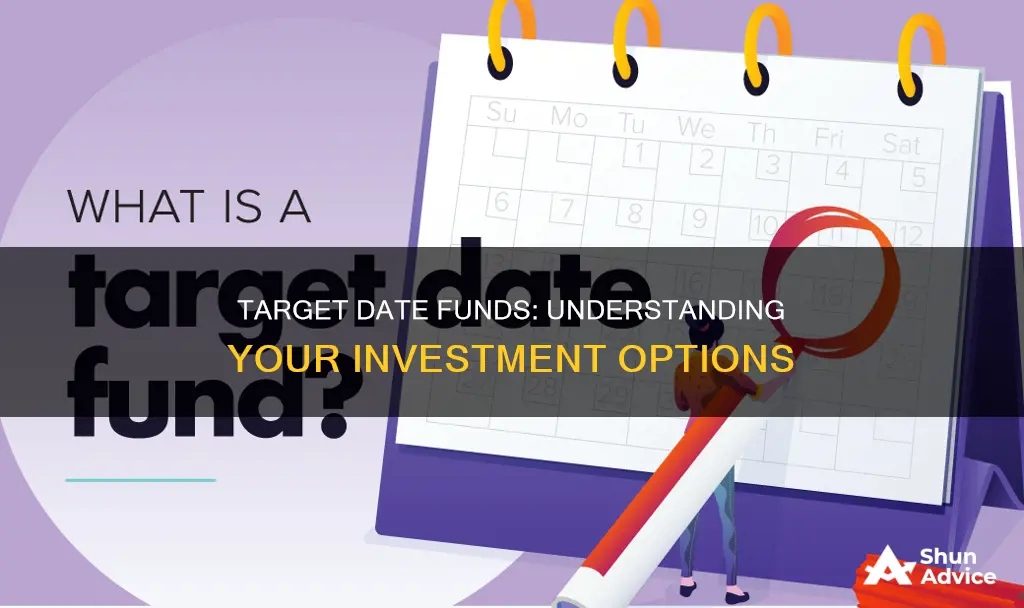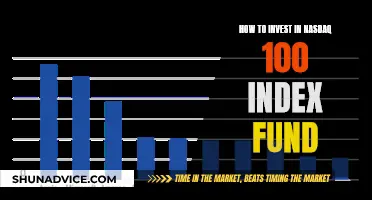
Target-date funds are a type of investment fund that automatically adjusts its asset allocation over time to meet the investor's objective. They are designed as long-term investment accounts that shift from riskier growth stocks towards more conservative investments as the investor approaches a specific milestone, such as retirement. These funds are often used in 401(k) plans and individual retirement accounts (IRAs) and can be actively or passively managed. Target-date funds typically include a mix of stocks, bonds, and other investments such as real estate or Treasury Inflation-Protected Securities (TIPS). The asset allocation is gradually adjusted based on a glide path, which determines the risk exposure and diversification levels over time. The funds are named according to their target date, such as Target Retirement 2070, indicating the year in which the investor plans to retire and start withdrawing funds.
| Characteristics | Values |
|---|---|
| Purpose | Long-term investment for individuals with particular retirement dates in mind |
| Investment type | Mix of stocks, bonds, and other investments |
| Management | Actively managed, passively managed, or a blend of the two strategies |
| Risk | High-risk in early years, low-risk in later years |
| Returns | Not guaranteed |
| Fees | High expense ratios |
| Customisation | Limited |
What You'll Learn

Target-date funds are a set it and forget it investment option
Target-date funds are a "set it and forget it" investment option. They are designed to be long-term investment accounts that are automatically adjusted over the years as the investor approaches a specific milestone, such as retirement. This makes them an attractive option for those who don't want to constantly reconsider and adjust their investment choices.
Target-date funds are often a type of mutual fund that holds a mix of stocks, bonds, and other investments. The mix of assets in the fund is automatically adjusted over time to become more conservative as the investor gets older and closer to their target date. This means that target-date funds can help to alleviate the stress and complexity associated with financial planning for retirement.
The funds are named according to their target date, which is usually the year in which the investor plans to retire. For example, an investor planning to retire in 2040 would choose a "Target 2040" fund. The asset allocation within the fund will gradually shift towards more conservative investments as the target date approaches. This means that the fund becomes less focused on high-performing but speculative assets, such as stocks, and more focused on lower-risk, fixed-income investments such as bonds and cash.
While target-date funds offer a convenient and relatively hands-off approach to investing, it's important to remember that they may not suit everyone's needs. It's crucial to monitor your investments periodically and ensure they are still aligned with your financial goals and risk tolerance. Additionally, target-date funds may have higher fees compared to other investment options, so it's important to consider the potential impact on returns.
Overall, target-date funds can be a great option for those seeking a long-term, hands-off investment strategy, but it's important to do your research and understand the potential benefits and drawbacks before investing.
Understanding Passive Index Funds and Their Investment Types
You may want to see also

They simplify the process of investing for retirement
Target-date funds are designed to simplify the process of investing for retirement. They are a "set it and forget it" investment option, meaning that once an investor has selected a fund, their asset allocation will be automatically adjusted over time. This makes the process of investing for retirement more straightforward, as investors do not need to constantly monitor and adjust their portfolio.
When selecting a target-date fund, an investor simply needs to choose the fund with a target date closest to their planned retirement year. For example, a 22-year-old today who plans to retire at 65 might choose a 2065 target-date fund. The fund will then be managed by professionals, who will adjust the mix of stocks, bonds, and other investments over time to align with the investor's risk tolerance at different stages of their life.
Target-date funds are designed to take more investment risks when the investor is young, gradually shifting towards more conservative investments as they approach retirement. This means that investors do not need to worry about adjusting their portfolio themselves as they get older. The fund managers use a glide path to determine the appropriate level of risk for investors at different points in time.
Target-date funds are also convenient because they are often available through 401(k) plans and are sometimes used as the default investment option for plan participants. This means that many people may already be invested in a target-date fund without realising it. Overall, target-date funds provide a simple and low-maintenance way to invest for retirement.
Best TSP Funds to Invest in Now
You may want to see also

They are a mix of stocks, bonds, and other investments
Target-date funds are a mix of stocks, bonds, and other investments. They are designed to be long-term investment accounts that are automatically adjusted over the years as the investor approaches a specific milestone, such as retirement. The funds are named according to their target date, for example, "Retirement Fund 2030" or "Target 2030".
Target-date funds are often mutual funds that hold a mix of stocks, bonds, and other investments, such as cash or cash equivalents. The mix of investments is designed to gradually shift over time according to the fund's investment strategy, typically starting with a larger proportion of stocks and becoming more heavily weighted towards bonds and other lower-risk investments as the target date approaches.
The exact mix of investments in a target-date fund will vary depending on the fund provider and the target date. For example, a fund with a target date further in the future is likely to have a higher proportion of stocks, while a fund with a target date in the near future is likely to have a more conservative mix of investments.
Target-date funds are designed to be a "set it and forget it" investment option, where the asset mix is automatically adjusted over time to become more conservative as the investor gets older. This can help to alleviate the stress and complexity of investment management for individuals who are not experts.
While target-date funds offer a convenient and diversified investment option, it is important to note that they may not be suitable for everyone. Some potential disadvantages include higher fees, a lack of customization, and the possibility of becoming too conservative too quickly, which could impact potential returns. It is important for investors to carefully consider their financial goals and risk tolerance before investing in target-date funds.
Key Factors to Consider Before Investing in Mutual Funds
You may want to see also

They are designed to be long-term investments
Target date funds are designed to be long-term investments. They are often used for retirement savings, with investors choosing a fund based on their target retirement date. For example, someone who is 22 and plans to retire at 65 might choose a target date 2065 fund.
These funds are designed to be a "set it and forget it" investment option, automatically rebalancing and reallocating assets over time without the investor having to do anything. This makes them a good choice for people who don't have the time or inclination to constantly monitor and adjust their portfolio.
When investors are young, target date funds are focused on growth and are weighted towards stocks and other higher-risk, higher-reward assets. As the target date approaches, the fund gradually shifts towards more conservative investments such as bonds and cash to preserve gains and avoid losses. This shift is known as the "glide path".
Target date funds are usually named to correspond with the planned retirement year of the investor, making it easy to choose the right fund. For example, the Vanguard Target Retirement 2070 Fund (VSVNX) is designed to reach the investor's objective in 2070.
While target date funds are a long-term investment, investors can make adjustments if their plans change. For example, if they decide to work for five more years, they can move their money into a 2065 fund or one with an even later date.
Roth Funds: Where to Invest and Why
You may want to see also

They are managed by professionals
Target date funds are managed by professionals, and this is one of the key benefits of investing in them. These professionals are portfolio managers who use a tool called a
The fund managers use the target date to determine the degree of risk currently appropriate for the investor. They typically readjust portfolio risk levels annually, shifting the fund's investments from riskier options like stocks to more conservative options like bonds as the target date approaches. This is done to preserve gains and avoid untimely losses.
The autopilot nature of target-date funds means that investors can put their investment activities on autopilot, eliminating the need to constantly monitor and adjust their portfolio. This can reduce the stress associated with financial planning as investors approach retirement. However, it's important to note that the predetermined shifting of portfolio assets may not suit an individual's changing goals and needs.
While target-date funds are managed by professionals, it is still important for investors to monitor their investments from time to time, especially after significant life changes, to ensure that the fund continues to align with their goals and risk tolerance.
Fixed Income Funds: Where Are Your Investments Going?
You may want to see also
Frequently asked questions
Target-date funds are a "set it and forget it" investment option that removes the need for investors to decide on a mix of assets and rebalance those investments over time. They are designed to be long-term investment accounts that are automatically adjusted over the years as the investor approaches a specific milestone such as retirement.
Target-date funds are typically made up of a mix of stocks, bonds, and other investments. The funds are designed to invest heavily in riskier growth stocks in the early years, gradually shifting towards more conservative investments such as bonds and cash as the target date approaches.
Target-date funds offer a simplified, automated investment approach that can help investors stay on track towards their financial goals. The funds are designed to strike a balance between the risk necessary for wealth accumulation and safer options to protect accumulated wealth. Additionally, target-date funds can help mitigate the risks of market timing by removing the emotional aspect of investing, which often leads to buying high and selling low.







